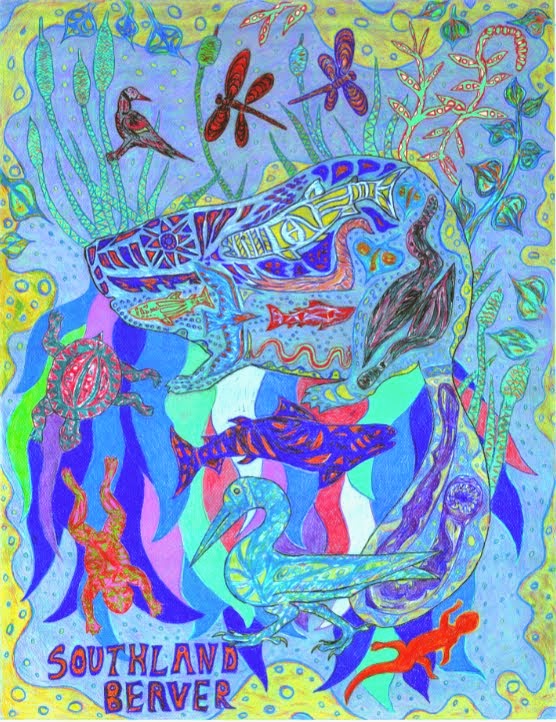Led Zeppelin- When the Levee Breaks (Play Loud)
If it keeps on raining the levee is going to break....
Yes what started as a drip, then a trickle, growing into a flow, is now a torrent. When I first started this blog there was the groundbreaking work on beavers in semiarid eastern Oregon to rehabilitate streams and steelhead/salmon habitat: Cheap and Cheerful Stream restoration with Beaver? Drought stricken New Mexico decided to get proactive about a comprehensive statewide beaver management program. Then there was the awesome and timely paper on beaver ecology, management, and conservation of beaver in dryland stream habitats (Gibson/Olden 2014). The devastating California drought is waking people up about water conservation. Now there is huge interest in the salmonid/beaver workshop in Santa Barbara- the event ultimately selling out (for which I had to pull some strings just to get a pass myself). And now finally the paper which I have been waiting for for well over a year:
 |
| Current and Historic Range of Beaver in CA. CDFW Lanman et al |
The Historical Range of Beaver (Castor canadensis) in Coastal California: A Review of the Evidence
(Christopher W. Lanman, Kate Lundquist, Heidi Perryman, J. Eli Asarian, Brock Dolman, Richard B. Lanman, Michael Pollock) California Fish and Game 99(4): 193-221 (2013)
Yes, that levee just broke. If you thought beavers in southern California is crazy talk, that there is not enough water for them or suitable habitat, that they will harm steelhead- well time to just think again and get yourself on the right side of history. The beaver zeitgeist is here and is not slowing down.
From the discussion section of the paper:
There has been a tendency to underestimate the influence of beaver on ecosystems
(Pollock et al. 1994). The presence of beaver has been shown to increase bird, fish,
invertebrate, amphibian and mammalian abundance and diversity (Naiman et al. 1988, Rosell
et al. 2005). As an integral part of the ecosystem of historic California, beaver may have
benefitted many threatened species. Colonization of southern California streams by beaver is
associated with increased riparian habitat, especially dense shrubby willow, which is critical
habitat for federally endangered southwestern willow flycatcher (Empidonax traillii extimus)
(Finch and Stoleson 2000) and least Bell’s vireo (Vireo bellii pusillus) (Muller-Schwarze
and Sun 2000) populations. There is evidence that beaver dams provide important refugia
for endangered California red-legged frogs (Rana draytonii) (Alvarez et al. 2013) and
western pond turtles (Actinemys marmorata) (Alvarez et al. 2007, Lovich 2012). Similarly,
beaver ponds and bank burrows appear to provide refugia for endangered tidewater goby
(Eucyclogobius newberryi) (USFWS 2005). In a historical ecology study of the San Gabriel
River in southern California, it was estimated that since 1870, 86% of historical wetlands
have been lost especially in the lower floodplain (Stein et al. 2010). In contrast, in the tidal
Copper River delta beaver activity has been shown to increase freshwater surface area and
to prevent seasonal drying of the floodplain (Cooper 2007). Allowing beaver to recolonize
their historic range could reverse the ongoing loss of wetland habitat in California’s coastal
watersheds.
Documenting that beaver were historically extant in California’s coastal streams
may have important implications for declining salmonid populations. Pollock et al. (2003)
reviewed reports of beaver “perennializing” formerly seasonal streams, and Tappe (1942)
noted summer flows in several streams in northern California increased after beaver
colonized upstream reaches. Gallagher et al. (2012) reported on limiting factors for coho
salmon (Oncorhynchus kisutch) populations in coastal northern California streams and
concluded that winter habitat was critically important, recommending adding substantial
amounts of large wood to increase pool habitats, improve stream shelter in high winter
flows, and reconnect the stream to floodplain habitats. Beaver impoundments also increase
winter habitat, and whereas large woody debris may be associated with coho salmon smolt
production (SPP) of 6-15 individuals, SPP per beaver dam ranges from 527 to 1,174 fish,
indicating that promotion of beaver populations may have an 80-fold more positive impact
(Pollock et al. 2004). Salmon from Alaska to Oregon have clearly evolved in sympatry
with beaver and these anadromous fish ascend coastal streams with beaver dams, the latter
often overtopped or breached by high winter flows. Coho salmon can jump dams as high
as 2 meters (Bryant 1984, Powers and Orsborn 1986). Gard (1961) showed that rainbow
trout (Oncorhynchus mykiss) can also cross beaver dams and in both directions, with some
accounts of trout crossing a series of 14 dams (Pollock et al. 2003). Hood (2012) reported
that beaver dams tripled juvenile Chinook salmon (Oncorhynchus tshawytsha) survival in
brackish tidal marshes in the Skagit River delta of Puget Sound. Today California’s coastal
beaver are widely regarded as the non-native survivors of twentieth century translocations,
and when they cause flooding problems or fell trees, depredation permits are often provided.
Understanding beaver as native to coastal ecosystems may impact this decision-making.
 |
| Fillmore Fish Hatchery. Rainbow Trout. author |
Based on the results of our study, coupled with the recent evidence of historic beaver
in the Sierra Nevada (James and Lanman 2012, Lanman et al. 2012), and the long-established
nativity of beaver to the Central Valley, the Colorado River and California’s northern rivers
(Tappe 1942, Grinnell et al. 1937), we conclude that the historic range of beaver included
most of California, except the streamless portions of the southern deserts (Figure 4). We
consider the historic presence of beaver in the perennial streams in California’s deserts (e.g.,
the Mojave River) unverified, but highly probable, given their current presence in these
systems (Lovich 2012) and the historic and current presence of beaver in similar desert
streams in Arizona (Allen 1895).
 |
| Beaver Dam. Santa Ynez River. Author |
Support me on Patreon.
Like antediluvian salad on facebook.
Watch me on Deviantart @NashD1.Subscribe to my youtube channel Duane Nash.
My other blog antediluviansalad.blogspot

No comments:
Post a Comment